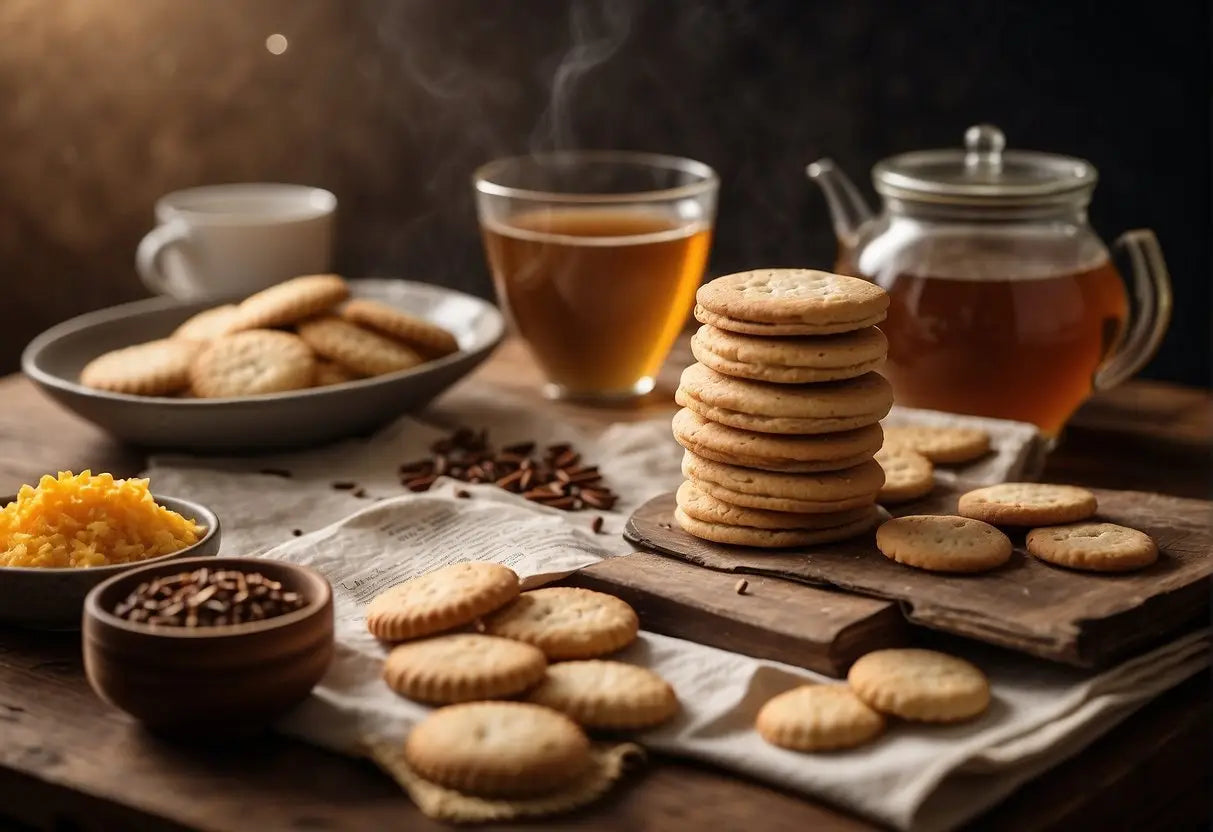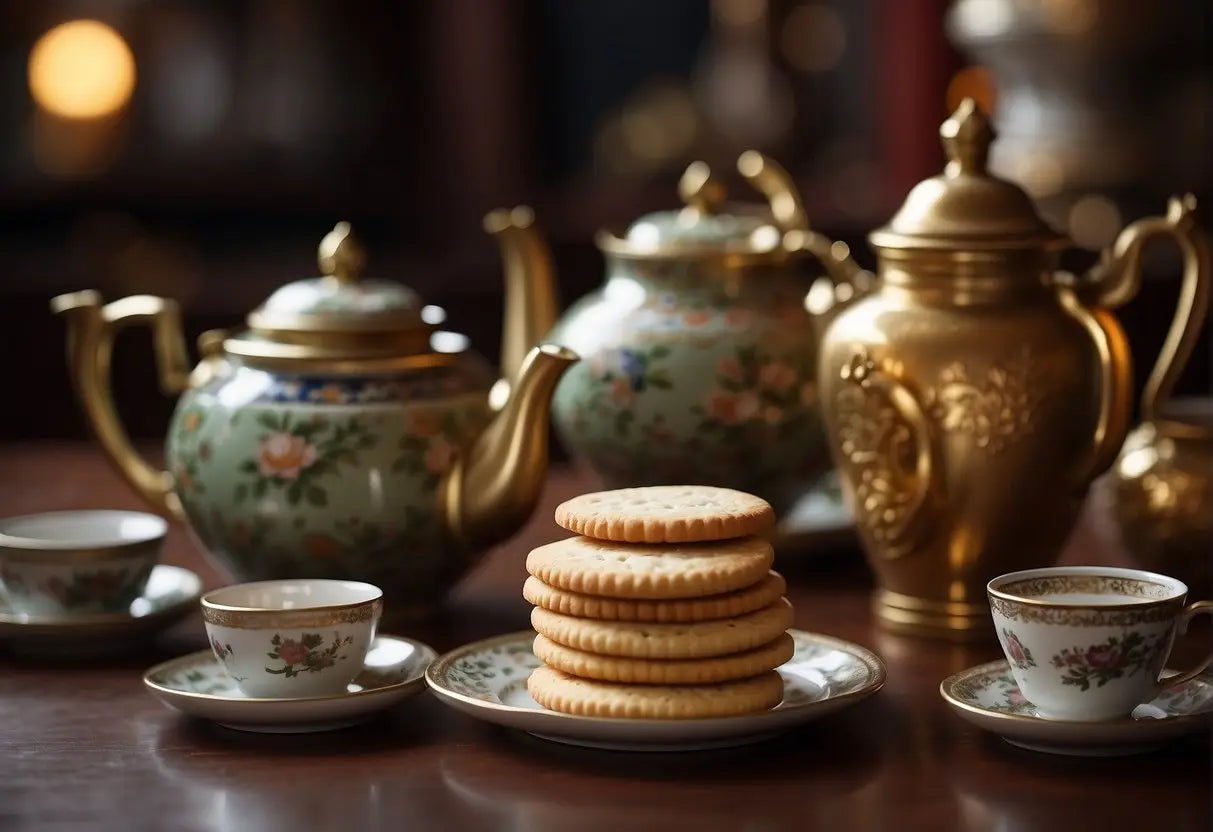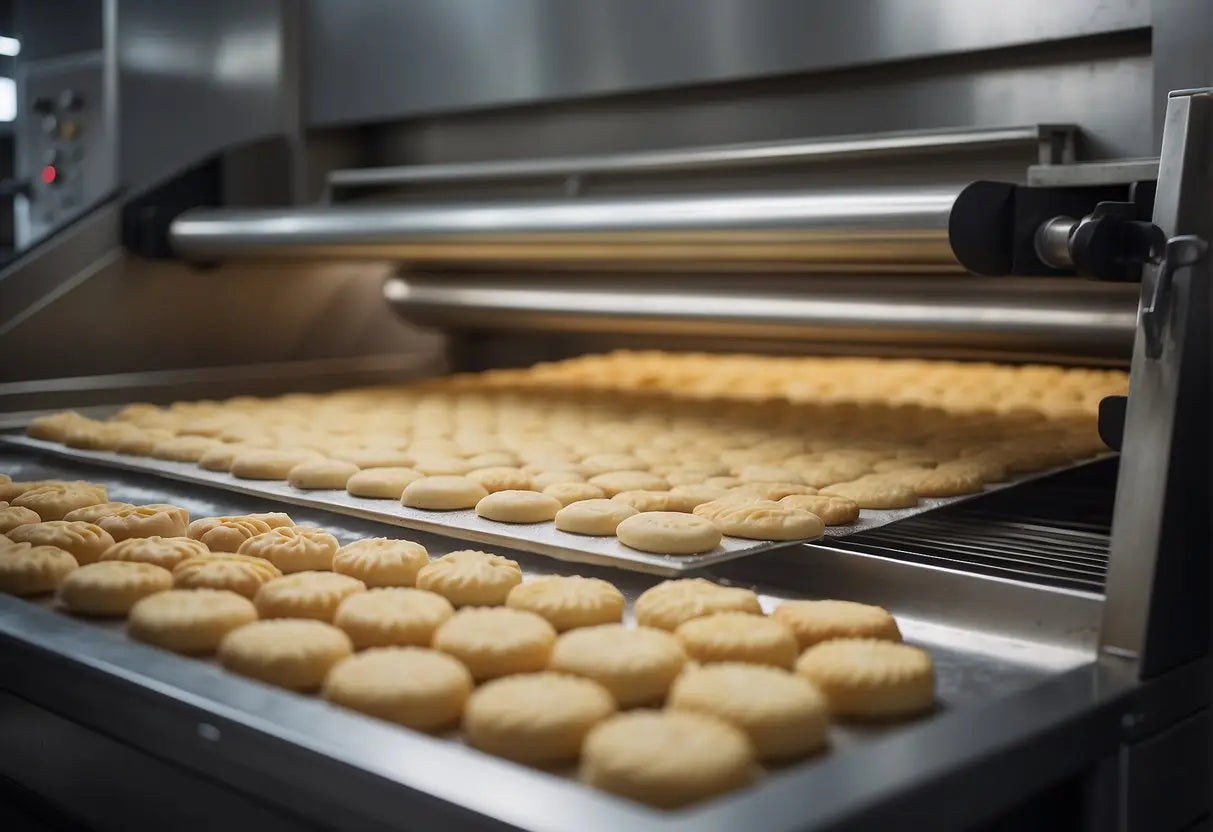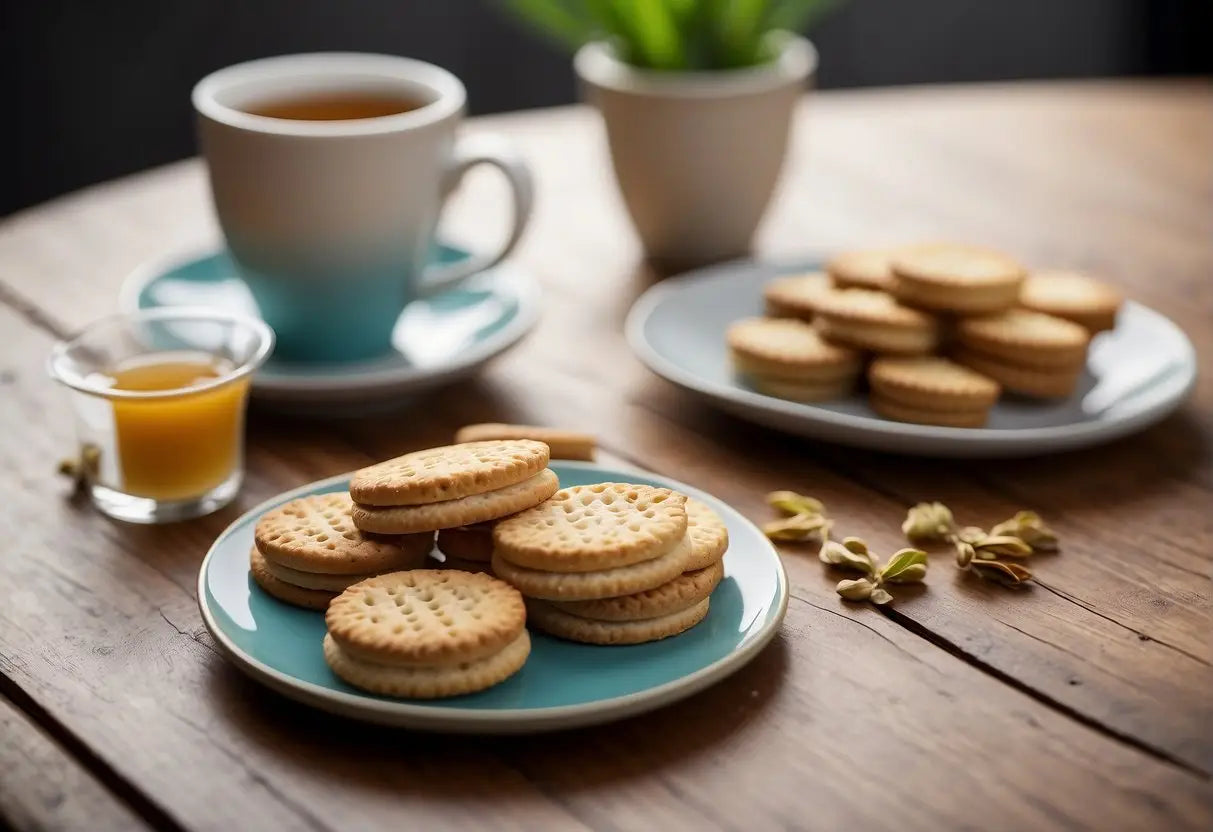Tea Biscuits
Tea biscuits originated in the United Kingdom during the 17th century. Initially, they were enjoyed as a luxurious item by the wealthy due to their costly ingredients and the expensive tea with which they were paired.
Evolution:
- 17th Century: Introduction as a luxury item.
- 18th Century: Becoming popular with the middle class.
- 19th Century: Mass production begins.
Through the years, tea biscuits transitioned from a treat enjoyed exclusively by the aristocracy to a common accompaniment to tea among the middle classes. The industrial revolution in the 19th century facilitated mass production, making them more accessible and affordable.
Bestsellers
Notable Types:
- Rich Tea: Simple and sweet, perfect for dunking.
- Digestive: A whole-wheat option with a distinct texture.
- Shortbread: A buttery choice from Scotland.
By the early 20th century, biscuit companies, like Huntley & Palmers and McVitie's, were established and became household names. These biscuits were crafted to withstand dunking in tea without crumbling too quickly— a crucial quality for the enjoyment of tea enthusiasts.
In modern times, tea biscuits are consumed globally and come in various flavors and textures. They are integral to social occasions, providing a sense of comfort and tradition. They're not just a British staple but have been adapted to suit tastes and teatimes worldwide.
Types of Tea Biscuits
Tea biscuits are a delightful accompaniment to your tea time, providing a range of flavors and textures to complement your brew. Explore these popular varieties to find your perfect match.
Butter Biscuits
Butter biscuits are known for their rich, buttery flavor and tender crumb. Crafted with a high proportion of butter to flour, they melt in your mouth and pair beautifully with both black and herbal teas.
- Main Ingredients: Flour, butter, sugar
- Texture: Tender, crumbly
- Taste Profile: Rich buttery flavor, mildly sweet
Digestive Biscuits
Digestive biscuits offer a wholesome, slightly nutty taste due to the use of wholemeal flour. They are less sweet than other types and are often enjoyed for their reputed digestive benefits.
- Main Ingredients: Wholemeal flour, baking powder, sugar, butter or oil
- Texture: Firm, crunchy
- Taste Profile: Subtly sweet, whole grain
Shortbread
Shortbread is a Scottish treat distinguished by its simple recipe and luxurious texture. These biscuits are perfect for those who appreciate subtlety and are looking for a small indulgence with their tea.
- Main Ingredients: Flour, butter, sugar
- Texture: Crisp, crumbly
- Taste Profile: Buttery, simple sweetness
Rich Tea Biscuits
Rich tea biscuits are a classic British staple with a plain flavor that makes them versatile for any tea type. They are often preferred by tea lovers who enjoy dunking their biscuits due to their firmness.
- Main Ingredients: Flour, sugar, vegetable oil, malt extract
- Texture: Firm, crunchy
- Taste Profile: Mild sweetness, malt undertones
Ingredients and Recipes

In this section, you'll find detailed ingredients and recipes to make classic tea biscuits, as well as gluten-free and vegan alternatives. Optimize your teatime snacks with these simple yet delightful recipes.
Classic Tea Biscuit Recipe
To make traditional tea biscuits, you need staple pantry items. Here is a standard recipe to yield about 12 biscuits:
Ingredients:
- 2 cups all-purpose flour
- 1 tablespoon baking powder
- 1/2 teaspoon salt
- 1/4 cup cold butter, cubed
- 3/4 cup milk
Instructions:
- Preheat your oven to 425°F (220°C).
- Mix flour, baking powder, and salt in a large bowl.
- Cut in the butter until mixture resembles coarse crumbs.
- Gradually add milk to form a soft dough.
- Roll out to 1 inch thick and cut with a biscuit cutter.
- Place on a baking sheet and bake for 12-15 minutes or until golden.
Gluten-Free Options
For a gluten-free version, the key is substituting the all-purpose flour with a gluten-free flour blend. Ensure your blend includes xanthan gum, which acts as a binding agent.
Lao Ban Zhang
Ingredients:
- 2 cups gluten-free flour blend
- 1 tablespoon gluten-free baking powder
- 1/2 teaspoon salt
- 1/4 cup cold butter or margarine
- 3/4 cup milk or dairy-free milk
Instructions:
Follow the same steps as the classic recipe, but with your gluten-free ingredients. Bake for 15-20 minutes or until they've attained a light golden color.
Vegan Alternatives
Substituting dairy and butter is simple in vegan biscuit-making. Opt for plant-based butter and milk.
Ingredients:
- 2 cups all-purpose flour
- 1 tablespoon baking powder
- 1/2 teaspoon salt
- 1/4 cup vegan butter, cold
- 3/4 cup plant-based milk
Instructions:
The method is identical to making non-vegan biscuits:
- Combine the dry ingredients.
- Cut in the vegan butter.
- Add plant-based milk and form a dough.
- After cutting the biscuits, bake them in a preheated oven at 425°F (220°C) for 12-15 minutes.
Cultural Significance

Tea biscuits hold a cherished place in social and culinary traditions. They are not only a treat but also a symbol of hospitality and comfort.
Tea Biscuits in the United Kingdom
In the United Kingdom, the tea biscuit is an integral part of the traditional tea time, a cultural ritual dating back to the 19th century. You'll find that in British society, offering tea and biscuits is a commonplace gesture of welcome in both homes and offices.
- Historical Roots: The custom of serving biscuits with tea began among the British upper class as an afternoon delicacy.
- Modern Day: Today, it transcends class boundaries and is enjoyed by all, often featuring a variety of biscuits like the Rich Tea, Digestives, and Hobnobs.
Tea biscuits in the UK are also essential during special occasions and are a staple during celebrations, such as Christmas and birthdays.
Global Variations
Around the world, tea biscuits take on different forms, flavors, and significances, reflecting the diversity of culinary practices.
- Italy: Biscotti, twice-baked and crunchy, are typically dipped in drinks.
- India: In India, the "chai biscuit" is a sweet or savory snack taken with spiced tea.
- Middle East: In many Middle Eastern countries, tea is often accompanied by sweet, buttery biscuits sometimes flavored with cardamom or saffron.
| Country | Name of Biscuit | Characteristic |
|---|---|---|
| Italy | Biscotti | Twice-baked, crunchy |
| India | Chai Biscuit | Sweet or savory, often spiced |
| Middle East | Various | Sweet, buttery, flavored with local spices |
Your experience with tea biscuits may vary greatly depending on where you are in the world, with each region offering its unique twist on this beloved snack.
Pairing with Tea

Choosing the right tea biscuit can enhance the flavors and experience of your tea-drinking ritual. Specific biscuits complement particular tea varieties, creating a harmonious balance between the two.
Black Tea Pairings
Black tea, known for its robust flavor, pairs well with rich, buttery biscuits. A classic choice is the Digestive biscuit, which can absorb the strong flavors without becoming too soggy.
- Earl Grey: Try a Lemon shortbread biscuit to echo the citrus notes.
- English Breakfast: A traditional Oat biscuit stays firm and adds a slight sweetness.
Green Tea Pairings
The delicate and sometimes grassy notes of green tea are best complemented by lighter, less sweet biscuits.
- Sencha: A plain Vanilla biscuit allows the tea's flavor to shine.
- Jasmine: Opt for a Almond cookie to match the floral notes without overpowering them.
Herbal Tea Pairings
Herbal teas can range widely in flavor, from floral to minty, and should be paired carefully to avoid clashing tastes.
- Chamomile: A Honey biscuit can highlight chamomile's gentle nature.
- Peppermint: Bold and refreshing, pair it with a Chocolate biscuit for a delightful contrast.
Manufacturing Process

When you start to manufacture tea biscuits, the first step is to collect all necessary ingredients. Typically, these include:
- Flour: The base of the biscuit
- Sugar: For sweetness
- Butter or Oil: Provides fat content for texture
- Baking Powder: A leavening agent
- Milk or Water: Used to form the dough
- Flavors: Such as vanilla, chocolate, or fruit essences
The process follows these steps:
1. Mixing: Combine all dry ingredients. Then, separately, mix the wet ingredients before merging both.
2. Kneading: The mixture is kneaded into a consistent dough. Adequate kneading ensures a uniform texture.
3. Rolling out: You will then roll out the dough to a uniform thickness.
4. Cutting: Using cutters, you shape the biscuits. This could be round, square, or themed shapes.
5. Baking: Place the cut biscuits onto a baking tray. The baking temperature and time are crucial — typically around 180-200°C (356-392°F) for 10-15 minutes.
6. Cooling: After baking, the biscuits must cool to room temperature to attain the right crispness.
7. Quality Control: Check the biscuits for consistent shape, size, and texture.
8. Packaging: Once they pass quality control, package the biscuits for distribution.
During this process, maintain cleanliness and follow food safety regulations. Use a food-grade facility and equipment for manufacturing. Always ensure ingredients are fresh and of high quality to produce the best flavor and texture in the final product.
Nutritional Information

When you reach for a tea biscuit, it's helpful to know its nutritional profile.
Calories: A standard tea biscuit averages between 40-60 calories, depending on the size and ingredients used.
Macronutrients:
- Carbohydrates typically make up most of the calorie content, with 5-10 grams per biscuit.
- Sugar contributes to the carb count and ranges from 1-3 grams.
- Fat content varies, with 1-2 grams per biscuit, including some saturated fat.
- Protein is minimal, usually less than 1 gram.
Fiber: Most tea biscuits contain less than 1 gram of dietary fiber.
Vitamins and Minerals: These are usually not significant in tea biscuits, but some fortified varieties may contain added nutrients.
Ingredients often include:
- Wheat flour
- Sugar
- Vegetable oil or butter
- Milk or cream (in some recipes)
Remember that ingredients like butter and cream increase fat content, while the use of whole-grain flours can provide more fiber. Your individual dietary needs should guide your choice of tea biscuits. Look for labels that list whole food ingredients and avoid those with excessive additives and preservatives.
Here's a simple breakdown per biscuit:
| Nutrient | Average Amount |
|---|---|
| Calories | 40-60 |
| Carbohydrates | 5-10g |
| Sugars | 1-3g |
| Fats | 1-2g |
| Saturated Fats | <1g |
| Protein | <1g |
| Dietary Fiber | <1g |
For more accurate information, always check the nutritional label on the package of your chosen product.
Packaging and Branding

When you select tea biscuits, the packaging plays a crucial role in your choice. It serves two primary purposes: protection and marketing. Packaging keeps the biscuits intact and fresh, so you expect materials that provide a barrier to moisture and air. Brands often use foil or plastic wrappers inside cardboard boxes or tins, which can be recyclable or reusable, adding a sustainability angle to their appeal.
The branding of tea biscuits is vital for recognition and differentiation in a competitive market. You'll notice that successful brands use distinctive colors, logos, and typefaces to create an easily recognizable identity. Here is a breakdown of typical branding elements:
| Element | Purpose |
|---|---|
| Logo | Emblem for company recognition. |
| Color Scheme | Evokes emotion and brand association. |
| Typography | Font styles that reflect the brand's personality. |
| Imagery | Pictures or illustrations that convey the product's quality and taste. |
Moreover, claims on the package such as “gluten-free,” "non-GMO," or “organic” inform your purchasing decisions. These claims are regulated to ensure accuracy, so you can trust the labels that detail health and dietary information.
Your experience with a brand also influences your perception. A consistent and positive experience builds loyalty. Companies aim to foster this through the packaging's tactile feel, the ease of opening and closing, or how well the package preserves the biscuit's crunchiness over time.
Remember, each design choice is deliberate. The next time you hold a package of tea biscuits, consider the thought that went into its packaging and branding to reach and resonate with you.
Consumer Buying Behavior
When purchasing tea biscuits, you tend to consider several factors that directly influence your decision-making process. Price is a critical aspect for you, as it needs to align with your budget. You're likely to compare prices across different brands and retailers before making a choice.
Preferences play a pivotal role as well. Your personal likes and dislikes regarding flavor, texture, and ingredients guide your selections. If you have dietary restrictions or health considerations, such as a gluten intolerance or a desire for low-sugar options, these needs heavily influence your purchases.
Here's a quick rundown of factors influencing your buying behavior:
- Price: Seeking the best value for money.
- Quality: Expecting a certain standard in the biscuits you choose.
- Brand Reputation: Tending to trust established brands with consistent quality.
- Packaging: Often influenced by the attractiveness and functionality of packaging.
- Availability: Preferring products that are readily available in your local stores or online.
You often rely on reviews and recommendations from others. Online reviews, ratings, and testimonials from friends can sway your decision, especially if you're trying a new product. If you're a repeat buyer, your previous experience with the brand or type of biscuit is usually the most significant factor in your future buying behavior.
Lastly, you might be swayed by promotions and discounts. Sales or special offers can prompt you to try new products or stock up on your favorites, sometimes leading to brand switching or the discovery of new preferences.
| Influence | Description |
|---|---|
| Price | Crucial factor aligning with budget |
| Quality | Determines the standard you expect |
| Brand Reputation | Trust in established brands |
| Packaging | Attractiveness and functionality |
| Availability | Easy access in local stores or online |
| Reviews & Recommendations | Peer and online feedback can influence choices |
| Promotions & Discounts | Sales and offers can lead to brand switching or trying new products |
Market Trends and Analysis

In recent years, consumer preferences have significantly shifted towards healthier options. You'll notice an increase in demand for tea biscuits with reduced sugar, whole grains, and gluten-free ingredients. This change is reflecting a broader trend in food consumption that emphasizes nutritional value.
Sales Channels have also evolved; with e-commerce experiencing a boost, you have the ease of purchasing your favorite tea biscuits online. Specialty stores are expanding their offerings too, catering to the niche market of artisanal and gourmet biscuits.
Geographically, Asia-Pacific regions are showing rapid growth, thanks to the increasing westernization of diets, whereas traditional markets like Europe continue to dominate in terms of sheer volume.
Here is a quick highlight of key data points:
- Healthy Options: 45% increase in health-centric biscuit sales
- E-commerce Growth: 30% year-on-year increase in online sales
- Market Leaders: Europe holds a 35% market share, Asia-Pacific at 20% (and growing)
Packaging Innovations are becoming prominent, as they play a role in both sustainability and branding. You’ll find tea biscuits with biodegradable packaging to be more prevalent as companies respond to environmental concerns.
In terms of pricing, there's been a slight uptick. However, the premiumization of products has allowed manufacturers to maintain profit margins despite the rising costs of natural ingredients. This indicates a market that is resilient and adaptable to both economic and consumer behavior changes.
Remember, as a stakeholder in the tea biscuit market, staying abreast of these trends is critical for strategic planning and long-term success.
← Older post Newer post →











